The best cameras in 2025
Here are the best cameras for the money, including our favorite mirrorless cameras, DSLRs, point-and-shoot cameras and more.

If you're thinking about upgrading to one of the best cameras, there has rarely been a better time. But what is the best camera for you? It's a big question, and one that I get asked a lot.
The first thing you need to decide is what you need (which is not necessarily the same as what you want). You can spend thousands on a camera totally unnecessarily and still get what you want.
Are you just starting out? One of the best cameras for beginners would be perfect. Looking to upgrade from your beginner camera or old DSLR? One of the best enthusiast cameras would be perfect. Taking it real seriously now? You'll need one of the best advanced cameras.
If you're only shooting video, things are a little different. If you're a content creator, you'll want a vlogging camera or action camera. And if you just want a cute companion to document day-to-day life, an instant camera might be the best shout.
Whatever you need, we'll cover it here, up to a budget of $3,000 (so, essentially, everything up to professional cameras). Each model on this list has been reviewed by us and extensively tested, so you can assured that the all come highly recommended.
All you have to do now is read on. Here are the best cameras you can buy.

Pete heads up the cameras coverage here at Tom's Guide. He bought his first camera, a Fujifilm, back in 2015 and remains a passionate photographer to this day, both at work and in his spare time. He's also big into action cameras, using them to document his exploits on a motorcycle. Pete loves geeking out about cameras and comparing specs to help you find the right product for you.
The quick list
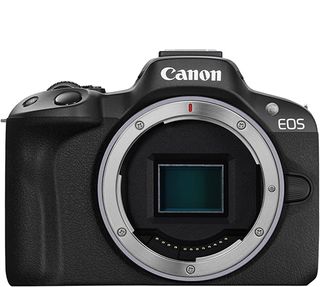
The best camera for beginners
The Canon EOS R50 is pricier than the entry level EOS R100, but offers a lot more. It's great for beginners and vloggers and will give them plenty of room to grow.
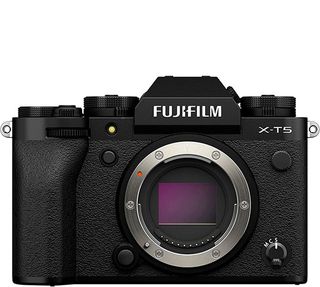
The best camera for enthusiasts
The Fujifilm X-T5 is an outstanding APS-C enthusiast tier camera. With a 40.2MP sensor, fast AF system and IBIS, it's built primarily for photographers, but packs 6K video for hybrid shooters too.
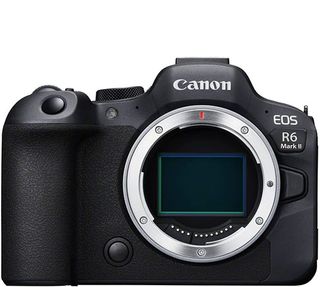
The best camera for advanced users
The R6 Mark II is as good a camera as you can buy within our price limit, offering fantastic AF, video and stills, albeit at a hefty price.
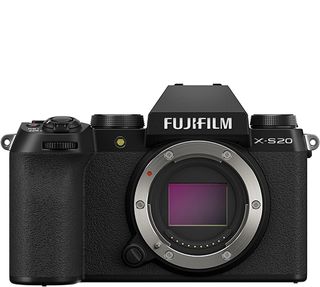
The best camera for content creators
For most people, from beginners through to experience enthusiasts and content creators, the X-S20 packs more than enough video firepower and produces lovely stills.
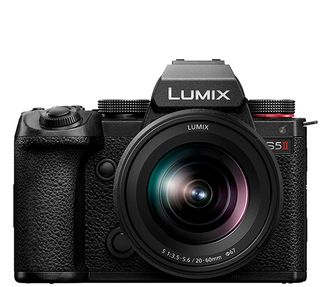
The best camera for video
The Lumix S5IIX is the best camera for enthusiast and advanced video shooters, packing enough firepower, specs and resolutions to satisfy even professional videographers.
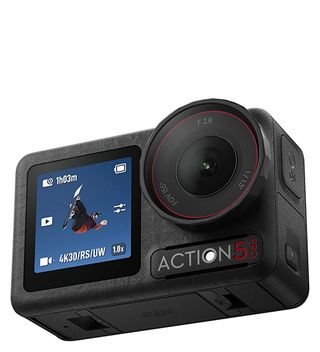
The best action camera
The DJI Osmo Action 5 Pro is our favorite action camera, with beautiful video, awesome audio features and best-in-class waterproofing. Better yet, it's $50 cheaper than a GoPro.
The best cameras you can buy today
Why you can trust Tom's Guide
We've split this list into a few different sections. Most manufacturers have ceased making DSLR cameras now, with the exception of Pentax, so our best ILC cameras list is essentially all mirrorless. We've broken that down into a few groups: beginners, enthusiasts, content creators, advanced and video. We've then covered DSLR separately, followed by compact cameras, action cameras and instant cameras.
The best camera for beginners
If you're just starting out on your photographic adventures, these are the cameras to choose. Just because something is a beginner's camera, that doesn't mean its bad or will take poor images — usually quite the opposite. Rather, these cameras prioritize price at the sacrifice of features that established photographers tend to want or need. They'll usually not pack very powerful video features either (although that isn't always true...)
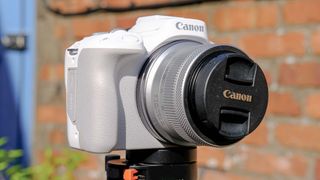
Specifications
Reasons to buy
Reasons to avoid
The Canon EOS R50 is our pick for the best camera for beginners. It's small and lightweight to come with you wherever your new photography or vlogging passion takes you. Meanwhile, it's well built, so it should last until you're ready to upgrade in the future.
It delivers beautiful stills, 4K video in 30p, natural colors straight out of camera, and Canon's ferocious autofocusing system. Indeed, it's the AF which really seals this camera as the best for beginners, as Canon has essentially packed into the R50 an (only slightly) slimmed down version of the AF found in its high end professional bodies — which is epic. There's also a flip out screen for vlogging, a dedicated product mode for demos and great vlogging and beginner kit options.
As with any beginner camera, there are a few compromises. It's a little pricey for a beginner body, and this is because realistically it isn't aimed at total newcomers. However, we think the features the R50 packs warrant the extra spend over the actual Canon entry-level body, the EOS R100, which is very basic. It could do with a few more direct controls on the body and when shooting at maximum resolution, the camera did start to overheat. None of these things change the fact that this is still a really great starter camera that will last you a while!
Read more in our Canon EOS R50 review.
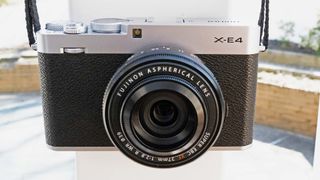
Specifications
Reasons to buy
Reasons to avoid
Fujifilm makes a range of cheaper cameras, but we'd recommend the X-E4 as the best camera for beginners wanting to enter the Fuji lineup. The X-E4 is a beaitiful camera to look at, with its retro aesthetic and trademark Fuji dials.
Its compact design and rangefinder layout make the X-E4 a great camera for street photography — even if you're more experienced, it's still a fantastic street camera — especially when you bear in mind Fuji's lineup of compact APS-C lenses. There are also Fuji's legendary film simulation color profiles, many of which lend themselves to street photography. Images produced by the 26MP sensor are beautiful, and the classic dials result in a more traditional experience when shooting. There are very few controls on the body of the X-E4, which can make for a challenging experience, but this all adds to the fun.
There's no IBIS (although that is expected in this price range) and the battery life isn't great, as the X-E4 still uses Fuji's older NP-W126S battery, so you'll want to buy a spare battery (thankfully third party ones are cheap).
There are cheaper Fuji cameras out there, but we think the X-E4 is the best balance of cost and features.
Read our full Fujifilm X-E4 review.
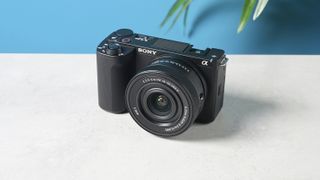
Specifications
Reasons to buy
Reasons to avoid
The Sony ZV-E10 II is an ideal upgrade if you want to take the leap from your smartphone to a proper video tool. You could invest in a slightly cheaper Sony compact camera, like the Z-V1, but you wouldn't have the flexibility of changing lenses. The ZV-E10 II is an ILC (interchangeable lens camera), giving you access to Sony's huge range of lenses, as well as affordable third party options. That makes this camera perfect for expanding your creativity to new areas and growing your video skills.
The ZV-E10 II is a purpose-designed vlogging camera, shooting 4K/60p and packing Sony's legendary autofocus, which did a phenomenal job at keeping us in focus during our vlogging testing. It's also super comfortable to hold, even at arms length, so you can vlog all day without worries. Versus the other beginner cameras on this list, it also offers excellent battery life, which is what you need when shooting 4K footage for YouTube. Better yet, it comes with a mic, so you can ensure your audio is as professional as your video.
The ZV-E10 II doesn't feature IBIS, although that's relatively normal in this price bracket and market segment. If you need IBIS, we'd recommend stepping up to the Sony a6700 or Fujifilm X-S20. There's also no viewfinder, meaning this is almost exclusively intended for use as a video camera.
All that said, if you're ready to take content creation more seriously, this is the ideal first camera to do it.
Find out more in out Sony ZV-E10 II review.
The best camera for enthusiasts
So, you're taking your photography a little more seriously now? Perhaps you're upgrading from a beginner camera or older camera. The enthusiast/intermediate market section is wide, so prices can vary. In general, they won't cost you as much as fully-fledged professional cameras, but have the specs to be used professionally if you needed to. They're a long-term camera that'll last you a long time and will take your photography to new levels.
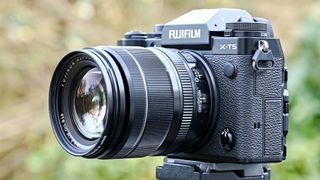
Specifications
Reasons to buy
Reasons to avoid
The Fujifilm X-T5 is the best mirrorless camera for enthusiast photographers. It may look and feel retro, but under the hood it boasts Fujifilm’s latest 40.2 MP X-Trans CMOS 5 image sensor and X-Processor 5 pairing. The high resolution sensor delivers outstanding image quality and leaves plenty of flexibility for cropping or large-format printing. With so many megapixels to play with, a manual shutter speed of 15 fps and electric shutter speed of 20 fps is impressive. However, in testing, the X-T5's buffers filled very quickly due to the lack of CFExpress ports, so you wont be able to utilize those faster shooting rates for long. Nevertheless, with a deep-learned AI autofocus system, the X-T5 will be able to keep up with even fast-moving subjects.
The ISO range is expandable to 51,200, and while its noise suppression is effective (it has to be when packing this many pixels onto an APS-C sensor), it does lead to an artificial smoothing effect and a loss of detail in images shot at higher sensitivity. Still, we came away with usable images even at ISO 12,800. Strong light metering and a range of Fujifilm’s beautiful color simulation profiles helps the X-T5 offer users a quality result without the need to be a post-production master, while its compact and lightweight design and 5-axis IBIS make it an excellent option for on-the-move shooting. Video performance is decent, offering up to 6K at 30p and 4K at 60p, but this camera is primarily designed for demanding enthusiasts and professional photographers — and there it excels.
Read our full Fujifilm X-T5 review.
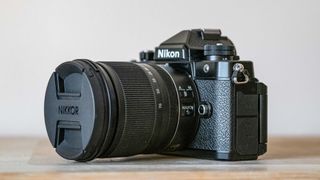
Specifications
Reasons to buy
Reasons to avoid
We absolutely love the Nikon Z f, and think it's one of the best intermediate and enthusiast cameras, especially if you'd rather have a full frame camera over the Fujifilm X-T5's APS-C sensor.
The Z f has a huge amount going for it. It uses a handsome retro design, similar to the X-T5 and comes with brilliant build quality. Its full frame sensor produces lovely images and video, and it has dual card slots for peace of mind when shooting (especially on paid jobs).
Unfortunately, one of those SD slots is a Micro-SD slot, which will hamper write speeds. It also presented some frustrating handling and control issues during our testing: its grip is very small, while the ISO dial does not feature an Auto ISO setting. It's also very expensive.
Given all the above, and that the Fuji X-T5 is both cheaper and features a higher resolution sensor, we still think that's the enthusiast camera to go for unless you really must have full frame.
Read our full Nikon Z f review.

Specifications
Reasons to buy
Reasons to avoid
Despite its age, the Sony a6600 still has a lot to offer the enthusiast photographer: an excellent sensor processor that deliver rgeat images, AI-enabled eye autofocusing in both still and video, 5-axis in-body image stabilization, 4K/60 fps video, and a speedy 11 fps shooting speed. Top that with a battery that can last up to 720 shots, and you've got one of the best camera options for the price.
In our Sony a6600 review, we were impressed with the image and video quality, as well as the camera's handling. It's made of a solid magnesium-alloy frame, and is both dust and moisture-resistant. It has a large, bright electronic viewfinder, as well as a 3-inch touchscreen that flips up a full 180 degrees and down 74 degrees. If you don't want to pay full freight for one of Sony's full-frame a7 cameras, the a6600 is the one to check out.
The a6600 is now ageing a little, though, and has been succeeded by the a6700, which is geared more towards video. There are also other APS-C mirrorless cameras that boast stronger photo and video credentials, such as the Fujifilm X-T5. Nevertheless, the a6600 is still a decent video performer, especially if you're already a user or a fan of Sony.
Read our full Sony Alpha a6600 review.
The best camera for content creators
These are the best cameras if you're shooting content for YouTube, online or social media. That isn't all they can be used for, of course, and many of them make excellent photography cameras too. However, these cameras balance powerful video features with usability and price.
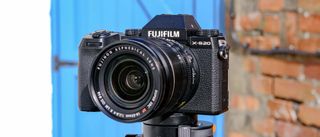
Specifications
Reasons to buy
Reasons to avoid
If you're a vlogger or content creator looking for best camera for YouTube or Social media content creation, look no further than the Fujifilm X-S20. It was really difficult choosing between this and the Sony a6700 for this category, but in the end we think the award has to go to the Fuji, thanks to its higher resolution video, wider range of vlogging features and, most importantly, lower price.
The X-S20 shoots beautiful 6.2K video at 30p, which is great for producing high quality vlogging content. There's also 4K/60p if you want to shoot in 60fps, which is better for faster paced content. There's a fantastic AF system with modes for people, faces, eyes, animals, and even vehicles, plus IBIS for smooth handheld footage. There are numerous specific vlogging features, too, including a vari-angle screen, a dedicated Vlog mode on the dial (which provides access to a touch screen menu with key vlogging features), a background defocus mode and a product priority mode (which changes AF to deprioritize faces — great for product demo vlogging). These aren't huge features, but they make the X-S20 a much easier camera than the Sony a6700 for less experienced vloggers who want an easy to use production tool. The lower price also helps with attainability.
What's more, while the X-S20 will be easier for newcomers, that doesn't mean it lacks the specs for more advanced users either — it's just as capable as the a6700.
If you're also interested in stills, the X-S20 takes beautiful photos, as you'd expect from a Fuji camera. For stills only, though, we'd recommend the Fuji X-T30 II or Fuji X-T5. If you already have an X-S10, the X-S20 is a decent upgrade, but only if you'll be shooting lots of video, where its beefed up battery and video specs will be most noticeable.
Read our full Fujifilm X-S20 review.
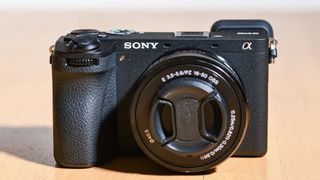
Specifications
Reasons to buy
Reasons to avoid
If you want to produce high quality video for YouTube or social media without breaking the bank, the a6700 is a fantastic choice. This camera packs incredible autofocus, 4K video oversampled from 6K at 60p, and can shoot 120fps slow motion at 4K. It's built beautifully, can take lovely photos and also gives you access to the huge number of Sony E-Mount lenses. There's also an awesome Auto Framing mode which gives solo shooters the effect of having a camera operator follow them through frame.
The EVF isn't the best in the price range, and there's no focus joystick on the back, which is a pain for photography. If you're relying on your video camera for any paid work, then the single UHS-II card slot is a big issue, as you won't have a backup of your footage or photos if your SD card goes kaput.
The main rival of the a6700 is the Fujifilm X-S20. We think the Fuji just pips the a6700 for vlogging, thanks to its Product Priority Mode and other vlogging features, as well as its lower price. These make it more attainable for newcomers to video, as well as those with more experience. The Fuji also shoots higher resolution video than the Sony at 6.2K versus the a6700's 6K oversampled 4K.
There are a couple of reasons to buy the Sony over the Fuji though. If you shoot a lot of slow motion, the a6700 features 4K/120fps recording for high resolution slow motion. The Fuji shoots at a higher 240fps, but only up to Full HD. There's also a larger range of lenses for Sony (although only by a small margin and you certainly won't be short of lenses with the Fuji). If you're already invested in the Sony E-Mount, this will be the video camera for you.
Read our full Sony a6700 review.
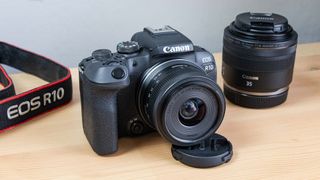
Specifications
Reasons to buy
Reasons to avoid
The EOS R10 can be had for around $1,000 with a kit lens, which is great value for money. It's definitely a big step up over DSLRs and even the EOS R50, so if you're looking to take photos and video more seriously, it's ideal.
The EOS R10 also offers some impressive video features for content creators, shooting 4K/60p and offering up to 10-bit color for a wide color gamut. This could make it a great camera for vlogging, especially in a home setup. It also features Canon's fantastic autofocusing modes, which will also be great for vlogging, but also for different types of photography, such as sports and wildlife. This camera is also super lightweight and relatively compact — ideal for street or travel photography.
However, the EOS R10’s lightweight design causes the body to feel cheap in-hand. Currently Canon’s RF-S lineup of bespoke APS-C lenses for their mirrorless R-System, is also lacking, meaning you’ll have to settle for non-native full frame RF lenses if you want fast maximum apertures or prime lenses. This camera also lacks IBIS, which is incredibly useful for handheld video — this is a big reason to choose the slightly pricier Fujifilm X-S20 or Sony a6700.
Read our full Canon EOS R10 review.
The best camera for advanced users
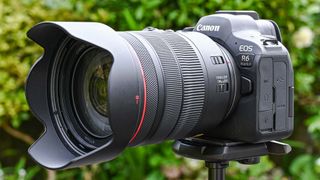
Specifications
Reasons to buy
Reasons to avoid
The original Canon EOS R6 long held the position of the most expensive camera on our best mirrorless cameras list. And the Canon EOS R6 Mark II continues that legacy. That said, while it's pricey, you get a lot for your money, The R6 Mark II is a camera designed for serious enthusiasts and professionals, with a feature set to match.
The EOS R6 Mark II is a professional hybrid camera, meaning it's designed for both stills and video. Its relatively modest megapixel count of 24.2 means it won't be the best for large photography printing jobs, but on the flip result in larger photosites (essentially pixels) than on a higher resolution sensor and therefore better low light performance. For video, there's 4K at 60p in 10-bit color, HDR PQ and C Log 3 available, all of which provide greater post-production flexibility for pro filmmakers.
Canon's deep-learned AI autofocus is just phenomenal, and can track human eys and faces, animals and vehicles, making this a versatile tool for different genres of photography.
If we're nitpicking, we'd have liked to see Canon's highest level BSI (Back Side Illuminated) sensor equipped, and pro users might have liked an OLED top panel display, as you'd find on the similarly priced APS-C Fujifilm X-H2S, and the EOS R5 (this camera's bigger sibling). However, if you have the budget, this is the camera to get.
Read our full Canon EOS R6 Mark II review.
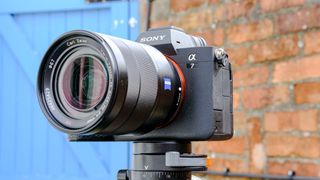
Specifications
Reasons to buy
Reasons to avoid
The Sony A7 IV continues the legendary legacy of the A7 mirrorless lineup. While it doesn't pack the resolution or hardcore features of the A7R line, the A7 IV is the all-rounder that provides professional features for a reasonable price. This is a great camera for anyone entering semi-pro or professional work, or dedicated enthusiasts who want a tool for serious photography.
The A7 IV packs Sony's fantastic AF, plus a high resolution 33MP full frame sensor, dual card slots and 4K/60p video. Its design priotizes handling speed, with its chunky grip and range of custom Fn buttons that allow you to map the camera exactly how you want. It's built like a tank and, of course, being a Sony, you'll have access to a huge number of full frame lenses from Sony and third party manufacturers.
The drawbacks? The A7 IV's shooting speed is relatively sedate compared to the other cameras we've listed in this section — only 10fps. If you need to shoot high speed photos, this isn't the camera for you. 4K/60p is only available in a crop; the rear screen is rather low resolution; and the 580-shot battery, while not exactly poor, won't last as long as the 700+ shot batteries in the Canon EOS R6 Mark II and Fujifilm X-H2S.
Read our full Sony A7 IV review.
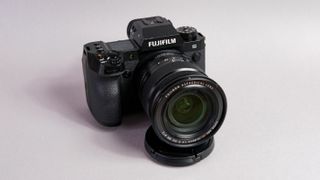
Specifications
Reasons to buy
Reasons to avoid
The Fujifilm X-H2S is Fuji's flagship APS-C professional camera, and the best APS-C camera you can buy... kinda. It's one of two best APS-C cameras you can buy, as the X-H2S has a sibling: the X-H2, which is focused on video and resolution.
The X-H2S features Fuji's 26MP sensor and latest X-Processor 5 image processor, which create stunning images with remarkably low noise given the sensor size. Thanks to its 40fps maximum drive rate, this camera is perfect for sports and widllife photography, especially coupled with Fuji's latest AF tracking modes, that bring Fujifilm cameras up to par with rival cameras from Sony and Canon.
Importantly, the X-H2S features a CFExpress Type-B card, which minimizes write times and allows for virtually no down time between high speed 40fps bursts, and a generous 170 RAW files and 184 JPEGs on continuous shooting. It's this CFExpress port that puts the X-H2S above the Lumix G9 II, which can shoot faster but does not feature a CFExpress port, so tends to get bogged down after bursts.
The CFExpress port also allows some impressive video specs, including internal Apple ProRES RAW recording in 6.2K/30p. If you want more resolution, the 40MP sensor in the X-H2 delivers high res photos and 8K video, at the expense of shooting speed.
This camera is heavy for an APS-C body and the AF can sometimes struggle shooting very small, fast wildlife, but it's one hell of a camera.
Read our Fujifilm X-H2S review.
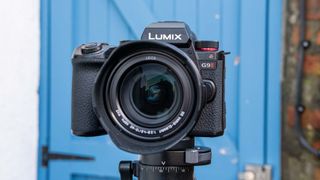
Specifications
Reasons to buy
Reasons to avoid
The Lumix G9 II is Panasonic's flagship Micro Four Thirds stills camera. It is aimed at enthusiast, semi-pro and professional photographers who need super high drive rates, and boy does this camera deliver that: it has a whopping 75fps continuous shooting rate.
That makes this camera perfect for sports and wildlife. It also features Panasonic's new hybrid PD/CD-AF, meaning the G9 II has tracking modes that can match Sony, Canon and Fujifilm. It'll track humans, eyes and wildlife, among other things. This finally brings Panasonic cameras into competition at the top end of the mirrorless market.
The G9 II is also built like a tank, and has lost the bulbous design of the previous model, sharing a body with the brilliant Lumix S5II. This camera is priced moderately for such a serious piece of kit, undercutting the other cameras in this section by a fair margin.
Unfortunately, this camera loses out to the Fujifilm X-H2S. Why? Its 75fps drive rate is impressive, but is undermined by only SD card slots versus the X-H2S' CFExpress port, which allows much less downtime after high speed shooting. There are also natural drawbacks to the M43 sensor, which produces incredibly destructive noise above ISO6400.
Read our full Lumix G9 II review.
The best camera for video
If you want the ultimate in video features, while also being able to use your camera for stills photography, you'll want one of the best cameras for video. Many of the other cameras in this list can shoot video very well, but these cameras are designed with video features first in mind.
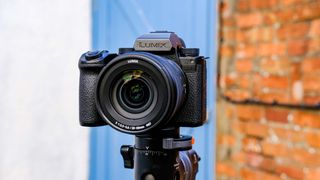
Specifications
Reasons to buy
Reasons to avoid
The Lumix S5IIX is the best advanced camera for video in our price bracket. Costing under $2,000, this camera will offer enthusiasts and semi-pro videographers all they need to produce professional quality video for their projects. Heck, it should even be more than enough for pro filmmakers too.
The Lumix S5II and S5IIX (they are separated only by a few additional video features on the S5IIX, some of which can be added to the base S5II via a paid firmware update) are the successors to the legendary Lumix S5, and follow very much in its footsteps. The S5IIX features a huge range of video resolutions and formats, compression types and bitrates, allowing users to customize their content to workflow, quality and storage requirements.
The camera features Panasonic's incredible IBIS system to keep everything stable when shooting handheld, and most importantly uses Panansonic's latest AF system — this is now a combined phase and contrast detection system, fixing one of the main issues on the original S5. As a mirrorless hybrid, it also takes beautiful images with lovely color rendition and all the benefits of a full frame sensor in regards to depth of field and low light performance.
Drawbacks? There are very few and we almost awarded this camera 5 stars. The AF is still a little spartan versus rivals in terms of detection modes — this is primarily why the R6 Mark II is still the better tool for hybrid advanced users and pros. There's no CFExpress port for fast data speeds when not shooting to SSD or external recorder — this is something you'd find on the Lumix GH6. And the 370-shot battery life isn't when compared to rivals. That said, for the money, this camera is phenomenal.
Read our full Panasonic Lumix S5IIX review.
We have covered an even wider lineup of mirrorless cameras in our roundup of the best mirrorless cameras — head there if you'd like to see more cameras compared.
The best DSLR cameras
With the exception of Pentax, most manufacturers have now turned away from DSLR and now focus on mirrorless cameras. However, you can still find DSLRs, so we've rounded up the best here.
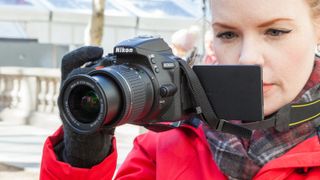
Specifications
Reasons to buy
Reasons to avoid
Sporting a 24-megapixel sensor, 3.2-inch swiveling touchscreen and compatibility with a huge range of lenses, the Nikon D5600 is the best camera for most people looking for a Nikon DSLR. In our tests, we found it took great photos, and has a nice wide usable ISO range. We also liked its battery life; rated at 970 shots, we were able to easily make it through a day's worth of shooting. With Nikon's traditional d-pad and a number of dials and knobs, it's great for experienced photographers looking for full-featured manual controls, while still including a number of assisted shooting modes to help teach and educate beginners.
One of our quibbles with the D5600 is that it can only capture video at a maximum resolution of 1080p/60 fps. However, that's not unreasonable for a camera at this price, and it has a dedicated microphone jack. All in all, it's a great kit.
Read our full Nikon D5600 review.
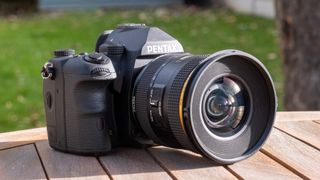
Specifications
Reasons to buy
Reasons to avoid
The Pentax K-3 III is the newest DSLR on the block, and it's a very good one — albeit with a few irritations. On the plus side, image quality from the new 25.7-megapixel APS-C sensor is outstanding, serving up bags of detail and accurate colors. Noise is supremely well controlled, and together with 5-axis in-body image stabilization that helps you get great shots in low light. Build quality is also excellent, with full weatherproofing, and there are plenty of manual controls; it's a fine camera to use.
Against that, autofocus can miss the mark at times and 4K video is only available in cropped mode. It won't rival the best mirrorless cameras in those regards, but as a straight still shooter it's an excellent addition to Pentax's line-up.
Read our full Pentax K-3 III review.
The best action cameras
Action cameras will go anywhere with you and record the whole adventure in high quality video. These are our favorites, which combine beautiful video with excellent stabilization and great smartphone apps, all wrapped up in affordable and compact packages.
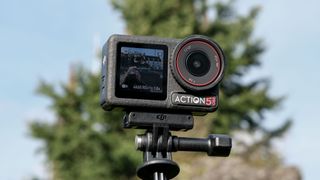
Specifications
Reasons to buy
Reasons to avoid
The DJI Osmo Action 5 pro is the best action camera around, shooting beautiful 4K at up to 120fps, which is all creators or casual shooters really need. The GoPro Hero13 Black's max res is 5.3K, while the Insta360 Ace Pro 2's is 8K, but those numbers are only meaningful for oversampling 4K footage in post production.
It isn't all about resolutions anyway. We put the OA5 Pro through its paces during testing and was mightily impressed. We loved the gorgeous OLED displays, plus the subject detection AF taken from the Osmo Pocket 3 for vlogging, while 47GB of internal storage nets you over an hour of 4K even with no card. This camera is waterproofed to 65 feet (20 meters), with a battery capacity of 1,950mAh for 112 minutes of 4K/60p (in our testing). As this is a DJI product, the internal mics are decent, but it can be wirelessly hooked up to DJI audio gear like the fantastic DJI Mic 2 microphone. Better yet, the Osmo Action 5 Pro is $50 cheaper than the GoPro Hero13 Black at launch!
DJI has fixed the issues that held the Osmo Action 4 back: namely stabilization and the smartphone companion app, DJI Mimo, meaning the Osmo Action 5 Pro's only real downside is that it tops out at 4K. If you aren't a pro (and even if you are) though, that likely won't matter much.
Find out more in our full DJI Osmo Action 5 Pro review.
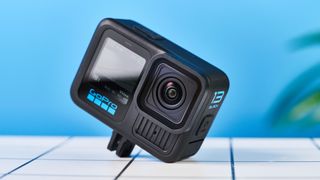
Specifications
Reasons to buy
Reasons to avoid
The GoPro Hero13 Black is the best GoPro you can buy. It's also our favorite action camera for professionals thanks to its 5.3K/60p recording plus its range of lens mods that give you lots of creative control over video, and turn the camera into a mini interchangeable lens camera like mirrorless and DSLR bodies above! With the Hero13 Black, GoPro also introduced HDR HLG and SDR Log recording, for wider dynamic range capture.
In testing, we loved the footage from the GoPro, which looks great and is beautifully stable thanks to GoPro's 'HyperSmooth 6.0' stabilization. It also packs some awesome timewarp modes, including specific modes for capturing light and star trails. There's also GoPro's Quick app, which is easy to use and provides basic editing features for free. With this model, GoPro has also finally introduced magnetic mounting, a feature that has been sorely lacking on GoPro's for a while, despite rivals having implemented it generations back.
The GoPro isn't our favorite action camera, at least not for most people. In testing at 4K/60p, its 80-minute recording time was well short of the DJI Osmo Action 5 Pro's 112 minutes. It's also $50 more expensive than the DJI Osmo Action 5 Pro. And while DJI and Insta360 have worked hard at closing the gap to GoPro in previous years (and never more so than with the Osmo Action 5 Pro), GoPro has just effectively sat on its hands and no innovated much: the Hero13 Black is essentially the same camera as the Hero12 Black.
Nevertheless, the GoPro Hero13 Black is still a fantastic action camera, so if you're already invested in the GoPro system, this is undoubtedly the one to get.
Find out more in our full GoPro Hero13 Black review.

Specifications
Reasons to buy
Reasons to avoid
The teeny, tiny Insta360 Go 3S takes everything its predecessor (the Go 3) did well, and did more! We absolutely love this diminutive action camera, and it's our top pick for casual creators needing a small action camera to mount in novel places: hat peaks, ties, or even car dashboards.
The Go 3S shoots 4K/30fps, which is a big step up over the original Go 3 and its 2.7K max res, and is waterproof down to 30 feet, so it's a great one to pack into a travel back for family holidays to the beach. The camera comes with an action pod, which extends battery life to 120 minutes at 4K and provides a flip-up display for vlogging and tweaking settings, although the pod itself is only splash proof so you won't want to dive into a pool with it.
The Go 3S has no removable storage, instead relying on up to 128GB of internal storage, although a fast transfer USB-C tool is available, and you can use the fantastic Insta360 app to quickly transfer footage to your phone. There's no external mic support either, but this is supposed to be a tool for casual creators, so that's understandable. The biggest drawback to the Go 3S is its price: this thing costs the same as a GoPro Hero13 Black and $50 more than a DJI Osmo Action 5 Pro, but if you need a small cam above anything else, there's no better choice.
Find out more in our full Insta360 Go 3S review.
The best instant cameras
Point, shoot and print. These cameras shoot stylish photos that are ready to display straight away. Here's our favorite, but check out our best instant cameras page to see more.
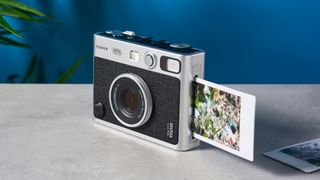
Specifications
Reasons to buy
Reasons to avoid
The Instax mini Evo is the best instant camera for most people, and for a few good reasons. Firstly, it's easily the best looking with its retro styling! It backs its looks up though, and offers extensive creative control. It offers 10 filters which can be combined with 10 lens effects, which means you can get 100 different creative combinations. It's also super compact and portable, making it a great travel companion.
None of that would be any good if the images were awful though, but this camera produces gorgeous images on the Instax mini film sheets it uses. In our review, the Instax mini Evo performed exceptionally well in all lighting conditions, too, so it's a great little camera to document evenings out with your friends or family.
This isn't just a simple instant camera, either, as the Evo has storage for 45 photos digitally, which you can print at a later date or transfer to your smartphone (although strangely, you can only transfer images to your phone if you're printed them first). There's also a microSD port, so you don't need to stress about running out of film and not being able to use the camera.
Any downsides? Well, if you're sticking to a tight budget, we'd recommend the Polaroid Go Gen 2 instead. If you can stretch your though, the mini Evo offers way more performance and creative controls. While $199 is steep for an instant camera, we feel like the mini Evo well justifies its price tag.
Read our full Fujifilm Instax mini Evo review.
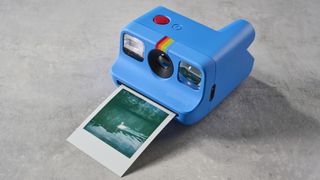
Specifications
Reasons to buy
Reasons to avoid
The Polaroid Go Gen 2 is our top instant camera for anyone on a budget. It's difficult to tell from photos, but this camera is actually super tiny, weighing only 8.4 ounces, making it (as Polaroid claims) “take anywhere-able”. And with a strong 15-18 shot battery life, it'll last you all day, making it a fantastic addition to your vacation checklist.
We absolutely loved the detailed prints this lovable little instant camera produces, and its built-in flash helps it expose pictures nicely. There's also a double exposure mode, a selfie mirror and a self timer for group shots. This camera offers you far less creative control than the Instax mini Evo above, but that also has an upside: it's super simple to use, making this camera ideal for beginners or people who just want an instant cam for quick, easy snapping.
It isn't perfect, though: despite its flash, the Go Gen 2 isn't a strong low light performer, so you'll want to spend a bit more on the Instax mini Evo above, if you need something for evening or nighttime shooting. There's no microSD port for storage, and the app is only for scanning in printed photos rather than storing native digital versions. It also uses Polaroid Go Color film, which is pretty expensive as film goes at around $1.12 per sheet.
Still, none of the Go Gen 2's drawbacks are major, and this cute little instant camera punches well above its weight division given its price. For under $100, it's a steal.
Read our full Polaroid Go Gen 2 review.
How to choose the best camera for you
There are a lot of factors that go into choosing the best camera for you. The first question you should ask yourself is what do you plan to shoot? If you're doing more portrait photography, and don't plan on moving the camera around a lot, a DSLR may be the best way to go. If you're looking for something more mobile, a mirrorless camera is probably a better bet. Be sure to check out our DSLR vs. mirrorless camera guide, which goes into detail about those two camera systems, and also scroll down for a bit more info about all of the options.
It's important to be realistic about your abilities and your intended use, as you can easily spend thousands of dollars on equipment that you don't need, or don't know how to use. Before making a purchase, it's also worth your time to go to a camera store to see how a particular model feels in your hands, and how comfortable you are holding it.
What different types of camera are there?
DSLRs
DSLRs — or digital single-lens reflex cameras — use a mirror to reflect light from the lens on to the sensor, and as a result are bigger and heavier than mirrorless cams. But they're still a great choice for beginners and enthusiasts alike, thanks to the ability to swap out lenses, good handling, sturdy build quality and excellent battery life. Some are also quite cheap these days, and they also benefit from large lens and accessory lineups. Canon and Nikon are the main players, with Pentax another option. Prices can range from a few hundred dollars to several thousand, but you can get a good one for as little as $450.
Here's our guide to the best DSLR cameras.
Mirrorless
These do away with the mirror of a DSLR but have the same advantage of being able to change the lens. As camera makers have switched to mirrorless they tend to get the latest tech, so they are often faster and have better autofocus and video options, plus features such as in-body stabilization. They're smaller and lighter, too, but battery life is not as good and there aren't as many lenses. Canon and Nikon both make mirrorless cams now, but the biggest player is Sony. Fujifilm, Olympus and Panasonic are all alternatives. Prices are similar to DSLRs.
Here's our guide to the best mirrorless cameras.
Point-and-shoot cameras
Also known as compact cameras, they can't swap lenses but are much smaller and lighter than either DSLRs or mirrorless cams. Some are small enough to fit in a pocket and they make great travel cameras. This is a broad category, with many different options; you can choose one for under $100 that you use simply as an alternative to a smartphone, or spend $1000 and get something with a big sensor and that takes photos to rival those from a DSLR. Sub-categories include tough cameras that you can use underwater or in extreme conditions and bridge cameras, which have a large body and very long zoom range.
Here's our guide to the best point-and-shoot cameras.
Instant
As the name suggests, instant cameras give you a physical photo as soon as you press the shutter (or a few seconds afterwards). They're basically what the old Polaroid cameras were, but updated — and indeed, Polaroid still makes some of the best. Many of them use different film formats that vary in size, so make sure you choose one that fits your needs. And also look out for extra features such as app integration and a flash.
Here's our guide to the best instant cameras.
Action cameras
These tend to be focused more on video than stills, although they will all do both. GoPro is the main player here (check out our guide to the best GoPro cameras for more), but all are designed to capture your daring exploits in (ideally) 4K footage.
Here's our guide to the best action cameras.
Cameras vs smartphones: Do you even need a digital camera?
These days, almost everyone has a very capable camera in their pocket, in the form of a smartphone. So is there still a need for a dedicated camera in 2023? To an extent, that depends on what type of camera you're talking about.
The best camera phones have now reached a level that would have seemed impossible a few years, with the likes of the iPhone 13 Pro Max and Samsung Galaxy S21 Ultra packing multiple lenses, large sensors (for a phone) and advanced software tricks. People can and do take incredible photos with their phone every day, and in some situations there really is no need for a dedicated camera.
But some types of camera still have key advantages over a phone. DSLRs and mirrorless cams, for instance, are still capable of taking better images than a smartphone in many situations.
That's partly due to sensor size — even the biggest smartphone sensors are many times smaller than those in an enthusiast DSLR. And because sensor size plays a key role in how much light a camera gathers, that has a massive effect on the overall quality of an image.
Lenses are another factor: while smartphones may have one or two wide-angle lens plus one telephoto lens, mirrorless cams and DSLRs have a choice of dozens, each optimized for its specific focal length or task.
Instant cameras can also do something that smartphones can't, while rugged cameras also have an advantage in one specific area (namely that they won't break if dropped down a mountain). With compact cameras, it's a different matter though, and unless you're looking for a really long zoom range, a smartphone may now be a perfectly good alternative.
Of course as the old adage has it, the best camera is the one you have with you — so either way, just make sure you get out there and use it.
How we test
Regardless of the type of camera we review, they're all subjected to a similar testing regimen: we use them in a variety of settings, including low light, outdoors, indoors and more. We also photograph a number of subjects, such as people and pets, to see how well the camera captures skin tones. If a camera comes with a kit lens, we generally use that lens with the camera, to more closely emulate the same experience as consumers purchasing the camera.
In addition to still and video quality, we also rate the camera based on its ease of use: are the physical controls easy to access, and are the menus logically laid out? Finally, we evaluate the camera's battery life and other features, such as wireless control. Once we've done all that, we're in a position to decide whether a model deserves to be on our best camera list.
Be sure to check out all of our camera picks:
Best DSLR cameras | Best action cameras | Best waterproof cameras | Best point-and-shoot cameras | Best instant cameras | Best mirrorless cameras | Best cheap cameras | Best GoPro camera | Best GoPro accessories | Best drones | Best 360 cameras | Best iPhone lenses | Best iPhone tripods |DSLR vs. mirrorless | Best Nikon accessories | Best Sony a6000 accessories | Best ring lights | Best ring lights for phones | best cameras for vlogging
The best apps and software for editing, managing, and sharing your photos:
Best photo organizer apps | Best photo storage sites | Best photo editing software | Best photo editing apps | Best photo collage apps
Sign up to get the BEST of Tom's Guide direct to your inbox.
Get instant access to breaking news, the hottest reviews, great deals and helpful tips.

Peter is Reviews Editor at Tom's Guide. As a writer, he covers topics including tech, photography, gaming, hardware, motoring and food & drink. Outside of work, he's an avid photographer, specialising in architectural and portrait photography. When he's not snapping away on his beloved Fujifilm camera, he can usually be found telling everyone about his greyhounds, riding his motorcycle, squeezing as many FPS as possible out of PC games, and perfecting his espresso shots.